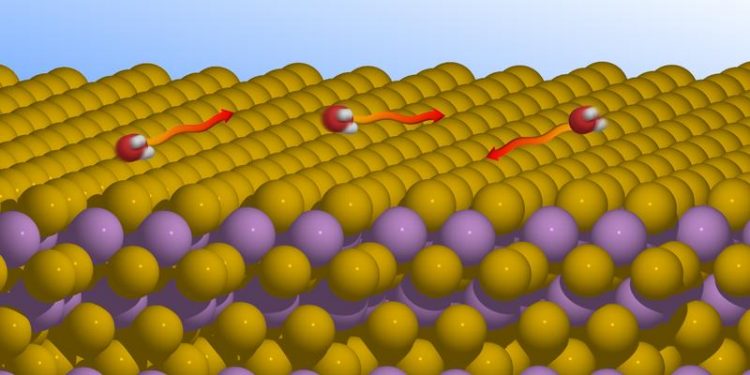The mysterious movement of water molecules

Schematic representation of the movement of water molecules on a topological insulator. © Tamtögl
Water is a mysterious substance. Understanding its behaviour on an atomic scale remains a challenge for experimentalists as the light hydrogen and oxygen atoms are difficult to observe with conventional experimental probes.
This is especially true when trying to observe the microscopic movement of individual water molecules which occurs on a pico-second time-scale.
As reported in their paper, entitled ‘Nanoscopic diffusion of water on a topological insulator’, researchers from the Exotic Surfaces group at TU Graz’s Institute of Experimental Physics joined forces with counterparts from the Cavendish Laboratory at the University of Cambridge, the University of Surrey and Aarhus University.
Together, they made significant advances, performing research into the behaviour of water on a material which is currently attracting particular interest: the topological insulator bismuth telluride.
This compound could be used to build quantum computers. Water vapour would then be one of the environmental factors to which applications based on bismuth telluride may be exposed during operation.
In the course of their research, the team used a combination of a new experimental method called helium spin-echo spectroscopy and theoretical calculations. Helium spin-echo spectroscopy utilises very low-energy helium atoms which allows the motion of isolated water molecules to be observed without disruption.
The researchers discovered that water molecules behave completely different on bismuth telluride compared to those on conventional metals. They report clear evidence for repulsive interactions between water molecules, which is contrary to the expectation that attractive interactions dominate the behaviour and aggregation of water on surfaces.
Bismuth telluride appears to be insensitive to water, which is an advantage for applications under typical environmental conditions. Plans are in place for further experiments on similarly structured surfaces, intended to clarify whether the movement of water molecules is attributable to specific features of the surface in question.
This area of research is part of TU Graz’s Advanced Materials Science Field of Expertise, one of the university’s five strategic research focuses.
Dr. Anton TAMTÖGL
Institute of Experimental Physics
Petersgasse 16
8010 Graz
Tel. +43 (0)680 3171626
tamtoegl@tugraz.at
Tamtögl, A., Sacchi, M., Avidor, N. et al. Nanoscopic diffusion of water on a topological insulator. Nat Commun 11, 278 (2020) doi:10.1038/s41467-019-14064-7
https://www.tugraz.at/en/institutes/iep/research/surfaces/ (Exotic Surfaces group at TU Graz’s Institute of Experimental Physics)
https://www.tugraz.at/en/research/fields-of-expertise/advanced-materials-science… (Overview Advanced Materials Science at TU Graz)
Media Contact
All latest news from the category: Life Sciences and Chemistry
Articles and reports from the Life Sciences and chemistry area deal with applied and basic research into modern biology, chemistry and human medicine.
Valuable information can be found on a range of life sciences fields including bacteriology, biochemistry, bionics, bioinformatics, biophysics, biotechnology, genetics, geobotany, human biology, marine biology, microbiology, molecular biology, cellular biology, zoology, bioinorganic chemistry, microchemistry and environmental chemistry.
Newest articles

Superradiant atoms could push the boundaries of how precisely time can be measured
Superradiant atoms can help us measure time more precisely than ever. In a new study, researchers from the University of Copenhagen present a new method for measuring the time interval,…

Ion thermoelectric conversion devices for near room temperature
The electrode sheet of the thermoelectric device consists of ionic hydrogel, which is sandwiched between the electrodes to form, and the Prussian blue on the electrode undergoes a redox reaction…

Zap Energy achieves 37-million-degree temperatures in a compact device
New publication reports record electron temperatures for a small-scale, sheared-flow-stabilized Z-pinch fusion device. In the nine decades since humans first produced fusion reactions, only a few fusion technologies have demonstrated…





















